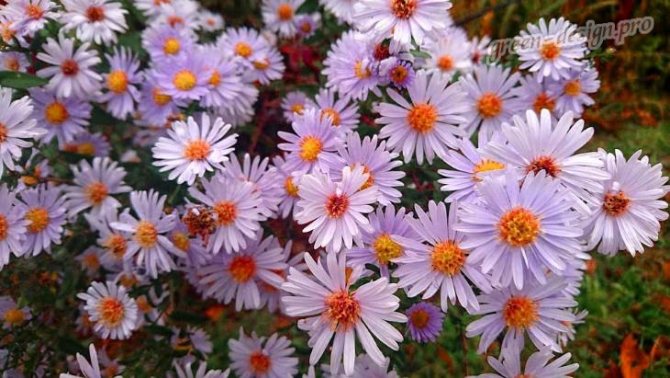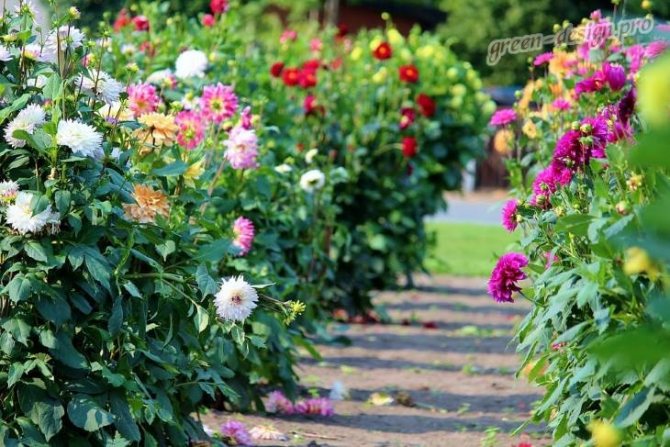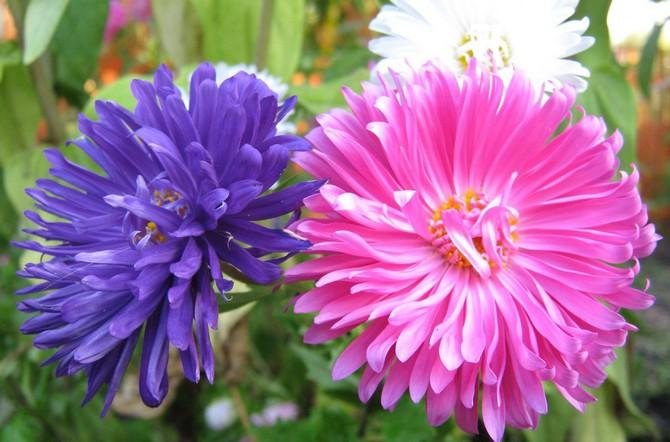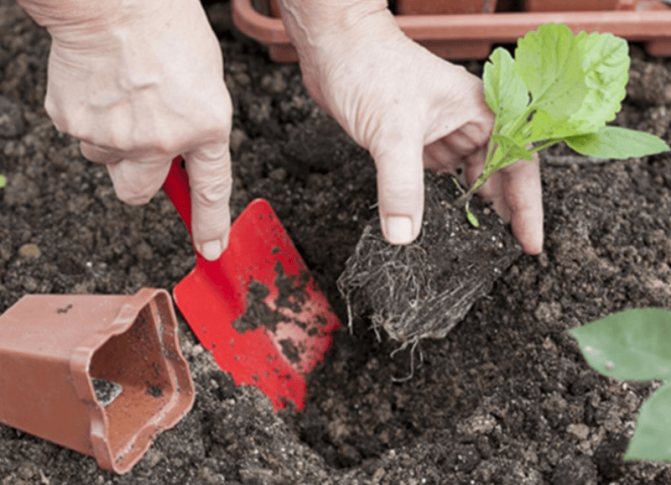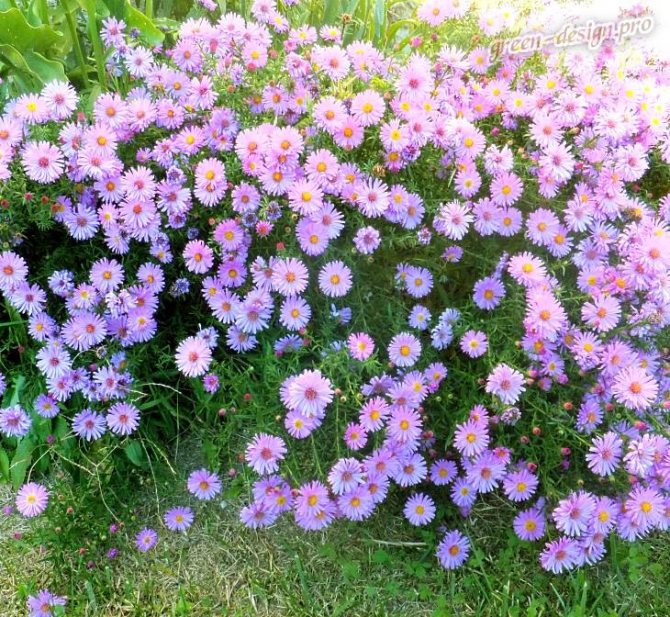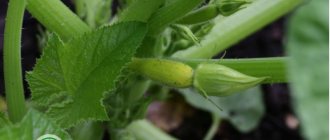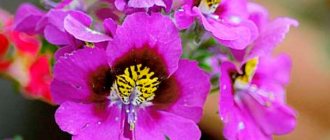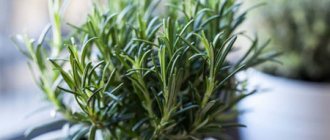Aster is one of the most popular flowering plants. In the second half of summer, its bright inflorescences can be seen in almost every area.
But few of the fans of these flowers know that there are more than 40 groups of asters, differing in the shape and color of the inflorescence, the splendor and height of the bush, and the flowering period.
Thanks to this variety, aster can be grown not only in a flower garden, but also to decorate a balcony, loggia or terrace with it. When growing asters, you need to know when to plant asters for seedlings.
History and origins of the aster
Plants - asters are annual and perennial. Let's start our story with annual asters, which are more familiar to our readers.
We love them for the duration of flowering, unpretentiousness, resistance to frost and, of course, for the beauty of white, pink, red, burgundy, yellow, blue and purple lush inflorescences.
Aster translated from Greek means "star". According to an old legend, this flower grew from a speck of dust that fell from a star.
According to popular belief, if you hide among the asters at night and listen, you can hear a subtle whispering. These are the asters talking to their star sisters.
Another name for the annual aster - Chinese callistephus - reflects both the beauty of the flower (callistephus translates as "beautiful wreath") and its homeland.
Photo. Voronezh asters: lilac, pink and blue
True, asters also grew in the northern regions of Japan, Korea, Mongolia, in our Far East, but for the first time they were brought to Europe from China. It happened in the first third of the 18th century. Since then, about 1,500 varieties have been bred. Unfortunately, not all of them have survived to this day, currently there are about 600 varieties in the world.
Aster breeding began in France, then Germany took up the baton, and later the USA, Denmark, Sweden, Poland, Sweden, Czech Republic and Slovakia. In our country, many decorative varieties have also been obtained.
Scientists S. V Zhegalov, O.D.Soskina, A.I. Kuznetsova, G.E. Christer have bred excellent varieties: Jubilee, Voronezh, Mtsenskaya pink, Mtsensk ruby, etc.
Since the mid-60s of the last century, G.V. Ostryakova has been working with great success at the Voronezh breeding station, the author of the magnificent and, moreover, resistant to fusarium asters: Raspberry ball, Galina, Lilac evening, as well as the pink variety of the Bride and the peony Yaroslavna.
For the wonderful asters Lada, Snow White, Irina, Suliko, Nata, flower growers are grateful to LB Ustinskova (VNIIS named after I.V. Michurin). Also, many wonderful varieties were obtained in Moldova, Ukraine, Belarus and other republics of the former USSR.
Unfortunately, at present, due to all kinds of restructuring and the liquidation of seed farms, the range of domestic asters has greatly decreased. Only, perhaps, the Voronezh breeding station managed to preserve the collection of our beautiful asters.
Outdoor care
After the plants are planted in a permanent place, it requires quality care. Carry out the necessary work on time, water, weed and loosen.

Watering
Astra does not tolerate waterlogging. Water as needed when the soil dries out. It is advisable not to plant flowers in places where groundwater runs close to the surface of the earth. The root system of plants does not tolerate waterlogging well.In hot weather, water is rarely, but abundant. Do not irrigate during rainy periods.
Weeding and hilling
Like all cultivated plants, aster does not tolerate the neighborhood with weeds. Weeding is carried out regularly. To reduce the number of weeds, the soil is loosened after each watering. In addition, the soil is saturated with oxygen and retains moisture. Hilling of plants is carried out in order to strengthen and stimulate the branching of the root system. It is carried out before branching, the height of the soil during hilling is 5-7 cm.
See also
How to get rid of chrysanthemum diseases, the main pests and their treatmentRead
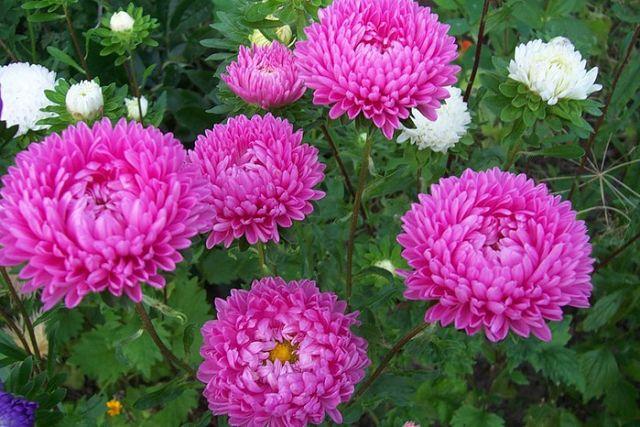

Top dressing
To increase the size of the flowers and the intensity and duration of flowering, the plants are recommended to be fed. Fertilizer is applied half a month after transferring the plants to the ground. Use nitroammofosku. Then the flowers are fed by spraying the bushes with minerals. Produced 1.5 weeks after the first feeding.
To improve the effect of dressing, mineral fertilizers and organic fertilizers are alternated. Before and during flowering, they are fed with a mullein. Calculation 1:10. Of the minerals used:
- superphosphate;
- urea;
- potassium chloride;
- urea and others.


Pruning and tying
Perennial asters need to be tied up, since tall bushes are unable to hold themselves. Especially with strong winds and precipitation. Bushes are tied to stakes. As for pruning, it is necessary to do it. Thinned bushes look more beautiful when forming a hedge. If you remove the tops of the branches, then there will be more inflorescences.
Asters, biological portrait of asters, shape, structure
The shape of the aster bush can be: columnar, pyramidal, oval, widely spreading, wide dense. The stem is usually strong, covered with coarse hairs. By height, asters are divided into high (50-80 cm), medium (30-50 cm) and undersized (15-30 cm).
Due to the fibrous root system, asters tolerate transplanting well even during flowering. The bulk of the roots is located in the upper soil layer, that is, at a depth of 15-20 cm.
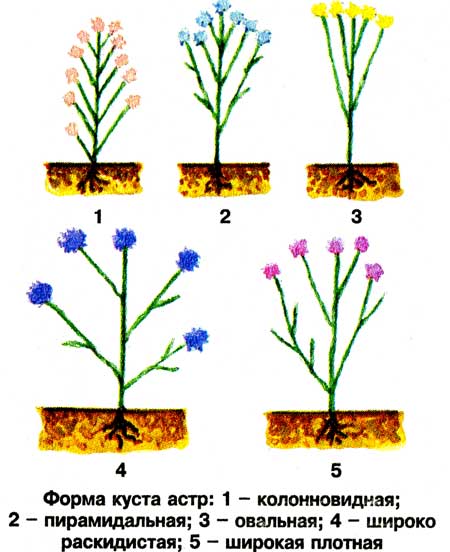

The leaves are spatulate, toothed, alternating. The largest are found on the lower part of the stem. When 4-5 leaves appear, buds are laid.
What we call aster flowers are basket inflorescences, and petals are real flowers. According to the size of inflorescences, asters are divided into small (up to 4 cm in diameter), medium (up to 6 cm), large (up to 10 cm) and very large (up to 19 cm).
Outside, the inflorescence is protected by a sheath of numerous oblong leaves. The outer leaves are green, the inner ones are filmy, colorless. Inflorescences are located singly on the main stem and lateral shoots of the first and second order. In shape and structure, they are flat, flat-round, hemispherical and spherical.
The flowers in the inflorescence-basket are mainly of two types: tubular and ligulate. Tubular located in the center. They represent a tube of accrete petals with a length of 0.2 to 1.5 cm.
The short tubular flowers in the middle of the basket are yellow in color, while the longer ones located farther from the center can be painted in different colors. The stamens and pistil are in the tube. These flowers are bisexual, they form seeds.
The second type of flowers in the basket is ligulate. They have 3 teeth at the top, corresponding to three fused petals, and a pistil.
It is these flowers that give the asters a unique charm. They are long, flat, ribbon-shaped, scapular-shaped, curly, twisted, fused into a narrow tube.
Reed flowers can be located along the edge of the basket in one row, and the entire center is filled with yellow small tubular flowers (non-double inflorescence) in several rows (semi-double) or almost completely fill it (densely double).In the latter case, there are very few tubular flowers, which means that few seeds are formed.
Aster inflorescences are most attractive at the beginning of flowering, then, as the central disc appears, the decorativeness of the inflorescence decreases.
Seeds are elongated-wedge-shaped, from light yellow to maroon (depending on the variety), 1 g contains from 300 to 500 pieces. To get 100 asters, it is enough to sow 0.5 g of seeds. They retain their germination capacity for 3 years at a storage temperature not exceeding 15 ° C.
If the temperature is higher, then the germination rate decreases and in the 4th year it is no more than 4%. For sowing, it is better to use the seeds of the previous year, they have the highest germination energy.
Asters have almost all the colors of the rainbow, except for green and black. Inflorescences are white, pink, salmon, red, yellow, blue, purple.
There are also two-tone colors, for example, the edges of the reed flowers are blue or red, and the middle is white.
According to the duration of the growing season and flowering time, asters are early, middle and late.
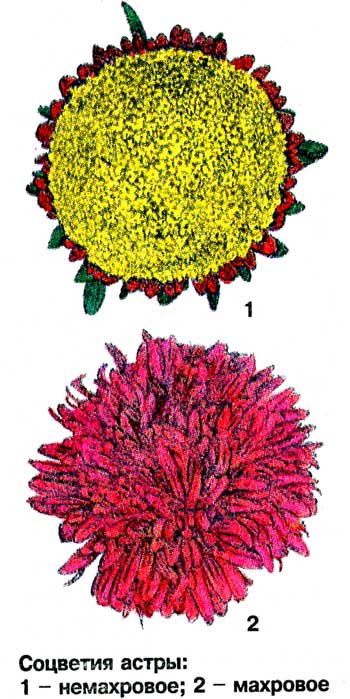

The period from germination to flowering is 95-106 days in the early (bloom in July), in the middle 107-120 (bloom in the first half of August) and in the late 121-126 (bloom in late August - early September).
The inflorescences bloom first on the central shoot, then on the first-order shoots from top to bottom. Flowering begins at the edges of the basket, covering 2-3 successive circles of flowers daily, and lasts 20-50 days.
Simple inflorescences fade faster, terry ones bloom longer. It is interesting that the doubleness of the inflorescences is not the same within the same plant - the least double ones are located on the main axis.
All asters are divided into 3 large groups.
Cut-off, intended for a bouquet, adorn large inflorescences on long, strong peduncles.
Universal asters form a bush of medium height with long strong peduncles and beautiful inflorescences, they are good for a bouquet and for a flower garden.
Casing - low compact plants with a large number of simultaneously and long flowering inflorescences, they are planted in flower beds and ridges, in mixborders, borders, balcony boxes and containers.
Aster seeds should be harvested when the disc of tubular flowers turns brown or brown and begins to "push". Blossom baskets should be cut only in dry weather, as the seeds in them can rot at high humidity.
Nina Ippolitova, candidate of agricultural sciences sciences
August - asters, August - stars ...
M. Tsvetaeva
So August is already approaching the middle - you will not notice how autumn will come (although summer this year also did not spoil us with warm days) ...
But August has its own special charm! He is rich in gifts! At night he gives us shooting stars - only have time to make wishes! And during the day, earthly stars delight the eye: amazing flowers - asters - bloomed in different colors in the gardens and on city flower beds!
And "aster" in translation from Greek means "star". And indeed, they are so similar!
If you've ever looked at a silvery star for a long time, you probably noticed that the star is not just a luminous point, emitting blue, then white, then pink light. The light of the star is not the same: in the middle it is bright yellow, golden, and at the edges it is, as it were, darkened. Emitting light, the star seems to be calling someone, sending signals to Earth, and probably receives responses! After all, it is not for nothing that sometimes they fall from the sky and fall down.
The ancient people, noticing this, began to look closely at the trees, flowers, trying to recognize the star interlocutor, and ... saw small light blue flowers with yellow circles in the middle, which, swaying from a light breeze, resembled the color and vibrations of the stars. - Astra! They exclaimed! Since then, this name has remained with him!
According to Greek legend, from the constellation Virgo, which for the Greeks was associated with the goddess of love Aphrodite, a tear rolled down - stardust. In those places that were touched by the stardust that flew to the ground, unprecedented flowers grew - asters, so reminiscent of heavenly stars by their inflorescences.
The Greeks believed that if you stand near the asters at night and listen, you can hear a slight whispering: it is the asters who have an endless conversation with their heavenly sisters - the stars.
The Chinese legend of the appearance of the aster is also associated with the stellar origin of flowers. One day, two Taoist monks went on a long journey to see the stars up close. They walked for a long time through a thorny forest, made their way through juniper bushes, climbed barely noticeable mountain paths, glided over snowy glaciers. Finally they reached the highest peak of Altai. But even at the top, they saw that the stars were still high in the sky, they did not come close to them at all!
Long was the way back. The monks had no water or food left, They stripped their bodies into blood, tore their clothes. Almost exhausted, they descended from the mountains and went out into a beautiful meadow, where a clear stream flowed and wonderful flowers grew. "Look, said one monk, we have come such a difficult path to see the stars in the sky, and they, it turns out, live here on earth." The monks dug up several plants, brought them to the monastery and began to plant these flowers, calling them asters.
Asters are low and tall, and their flowers have a wide variety of colors. Inflorescences can be very small, and can reach 17 cm in diameter. Currently, there are about 4000 different varieties of this flower. Many legends are associated with the plant.
Growing from seed by direct sowing in open ground
To properly grow plants, you must follow the recommendations given by experienced gardeners. Direct sowing into the ground reduces the labor intensity of cultivation, but significantly postpones the flowering period.
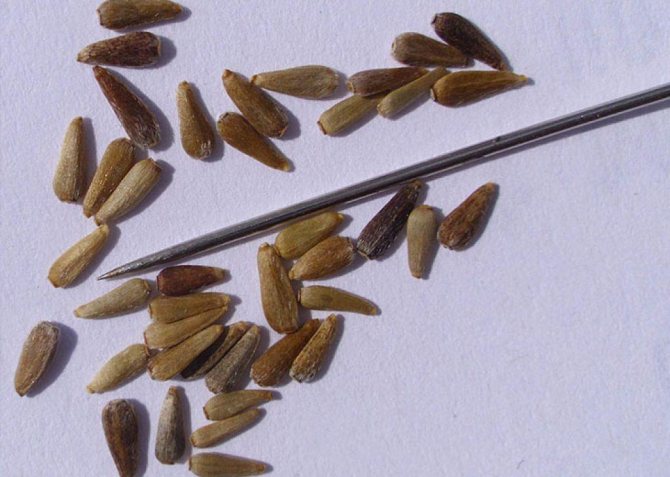

When to sow
It is necessary to wait for the soil to warm up. The optimal period is at the end of April and beginning of May. The summer resident calculates the day, correlating with the peculiarities of the climate of the region of residence. Planting material is planted in open ground not only in spring, but also in autumn. Then the planting time depends on the frost, since the seeds are planted in frozen soil.
Asters planted in this way bloom later, but more abundantly and longer. In the beds, grooves are formed in advance and planting material is sown in them. Sprinkle with a layer of mulch 3-4 cm thick, use humus or compost.
Choosing a place on the site
It is advisable to choose a well-lit area that will be protected from flooding and waterlogging. Drafts and strong winds are not loved by any culture.


Soil preparation
The garden bed is dug up, roots and weeds are removed. Provide nutrients. Make grooves, the depth of which is 2 cm. Then watered with a weak solution of potassium permanganate.
Sowing scheme
Sow in grooves made at a distance of 8-10 cm. Then cover with polyethylene. After emergence, the film is removed.
When the 3rd leaf appears, they break through at the distance necessary for a certain variety.
The legend of the Indians
There is a legend about the aster flower, which is passed from mouth to mouth by the Indians of the Oneida tribe. Once a young hunter fell in love with a pretty girl, but she did not reciprocate his feelings. He asked her: if he succeeds in knocking down a star from the sky, will she agree to become his bride? None of the other youths of the tribe offered her such a gift. The girl considered the hunter an ordinary braggart and agreed. And when the Indians from other tribes heard about this, they began to mock the young man. However, he continued to insist on his own, told the proud woman to come to the meadow in the evening.
When the stars lit up in the sky, all the young people from the tribe gathered to watch the hunter going to fulfill his promise. The young man directed his bowstring into the sky, and after a few moments in the distant expanses a star flew into many sparks, struck by the accuracy of the young hunter.
This story is suitable for those who are looking for flower legend for children. It continues with a story about how the formidable god reacted to the act of the young Indian. The celestial did not want the hunter to find his happiness. They were angry that a mere mortal dared to shoot at high stars. After all, others could follow his example, and then there will be no beautiful distant luminaries in the sky, no moon illuminating the Earth. God decided to send a violent storm to earth. She raged for three days and three nights. At this time, everything on earth was covered with impenetrable darkness. The sea went beyond the coast, and where the ocean was, on the contrary, land was formed. And when the storm died down, no one could find the young daredevil. It turned into a small flower, which was called "shooting star" by the Indians.
Plant symbolism in Ancient Hellas
Aster is a very ancient flower. In Ancient Hellas, she was considered an amulet capable of protecting against dark forces. In translation, the word "aster" means "star". According to another legend, it grew out of a speck of dust that fell from a distant star. That is why the flower was often considered a symbol of sadness, because it testified to the lost paradise, the inability to rise to the horizon again.
Aster in Ancient Greece was a revered flower. There were many temples dedicated to Aphrodite, in which the altars were decorated with images of asters. Also, this flower was used for fortune telling by young Greek women. Girls who dreamed of starting a family performed a special ceremony: they had to go to the night garden, approach the asters and listen carefully to their rustle. It was believed that flowers would be able to learn the name of the groom from the stars and inform the questioner.
Persephone's story
One of the most beautiful legends about the aster flower was composed by the ancient Greeks. It was they who wrote down the beautiful myth about the origin of this unusual plant, which is associated with the story of Persephone, the unfortunate wife of the ruler of the dark kingdom of Hades. As you know, this god stole her from her mother and forcibly took her as a wife. The inhabitants of Olympus ordered Persephone to be in the dark halls of the dungeon for six months, to spend six months with her mother. From year to year, the young goddess went up with the onset of spring, and went down when the cold came to the ground.
Tears of a goddess
This legend will arouse interest in a wide variety of age groups. The story is suitable for both adults and children. The legend of the flowers, which were once the tears of the goddess, continues with the description of what happened to Persephone. One day at the end of August, the goddess noticed a young couple in love. The young man and the girl exchanged kisses under cover of the night. Persephone, who was soon to return to the kingdom of Hades, began to sob from the despair that overwhelmed her. The goddess's tears turned into stardust, which fell to the surface of the earth and turned into wonderful asters. It is not surprising that this flower has always been associated with love among the ancients.
Pests and diseases
- Garden aster is very often affected by the black leg, which develops during the period of active plant growth. This disease may be due to too dense plantings. To rid the asters of this disease, the shoots should be treated with ash or Previkur.
- Due to high humidity, powdery mildew or rust may develop on the flowers, and fusarium may appear. To treat these diseases, flowers should be treated with Tattu or Ridomil Gold.
- Of the pests, aster is most afraid of aphids and spider mites. In the fight against such pests, the treatment of plants with the preparations Aktofit and Aktellik helps.These drugs are harmless to bees and humans.
- The malignant pest of asters, the moth, appears in August. The moth lays eggs on plant buds. Caterpillars hatching from eggs eat the inflorescences. To get rid of this pest, asters should be treated with Aktofit.
The Legend of the Clergy
However, not only the history of the ancient Greek goddess is associated with the emergence of this plant. There is another legend about the aster flower in China. Once, two Taoist priests set themselves the goal of getting to the stars themselves. As you might expect, their journey was long and full of difficulties. They walked through dense juniper bushes, made their way through forests, slipped on icy paths. Finally, they managed to reach the top of the Altai Mountain. When the clergy arrived at this point, they decided to take a little rest. After all, their legs were stripped in blood, only rags remained from their clothes. With difficulty they descended into the mountain valley. There they saw a beautiful lake and a flower meadow, where the aster grew. The legend about the flower says that the monks, having seen the plant, understood that wonderful stars can be found not only in the sky. They could not resist, so they took several flowers with them. Subsequently, the clergy began to plant these beautiful plants on the monastery lands.
How did the flower get to Europe?
Asters were brought to Europe from China back in 1728. They were brought to one of the most famous botanists of the time, Antoine Jussier, who was engaged in the cultivation of asters in the royal garden. The plant, which was grown under the new conditions, gradually changed. This was facilitated by his stay in greenhouses and careful care.
After 22 years, a completely new variety of asters was obtained. It took 22 years for the first terry aster to be bred. This species began to be called "Chinese aster". And at present, there are several hundred different species in the genus of asters. The simplest of them resemble chamomile in appearance; there are also amazing peony asters among them. They were bred by a botanist named Truffaut. This flower is annual and perennial. It blooms from the end of summer, and some species can bloom until the beginning of winter frost.
Asters have faded - what to do
After the plants have faded, it is necessary to collect seeds from them, and dig up and burn the plants themselves, so that all possible pathogens of fungal and viral diseases are destroyed and do not have the opportunity to infect other plants.
The collected seeds can be planted in the soil in another area immediately after the first frost and sprinkled with peat or humus. In December-January, it is possible to carry out sub-winter sowing in furrows right in the snow. And in the spring, when the snow melts, the seeds must be covered with foil.
Garden asters after flowering
Post-flowering care depends on the species. So, seeds can be collected from annual plants, and dried remains of stems and flowers can be destroyed. Perennials are pruned after drying, dug up and divided if necessary, seated and covered with mulch for the winter.
Attitude to the flower of different peoples
Aster is an autumn flower with which legends of various nationalities are associated. The Scythians considered the aster a symbol of the sun, and also regarded the flower as a divine gift. She is also one of the most beloved flowers among the Tatars. Astra is depicted on the state emblem of the Republic of Tatarstan. The aster and the Chinese gave a special meaning. They saw in him a symbol of love. Those who would like to activate the feng shui "love zone" were recommended to place this flower in it. In addition, the Chinese were convinced that the plant was able to protect a person from evil spirits.
Bookmark this site
The Russian name is Astra. Family - Compositae or Asteraceae Homeland - Europe, Asia, North Africa, Central and North America.
Growing and care
Astra is unpretentious, frost-resistant. It grows well in open sunny areas of the garden, tolerates partial shade well. But in sunny places it blooms earlier.
Prefers moist, but not waterlogged, loamy fertile soils. Before planting, it is necessary to dig up an area to a depth of 30-35 cm with the addition of 200 g of dolomite flour, as well as 3 tablespoons of superphosphate.
Please note: Excessively damp, shaded areas are unsuitable for cultivation.
Plant care is the removal of weeds, loosening the soil so that a soil crust does not form. Watering as needed.
Note that you need to increase watering during crop growth and dry weather.
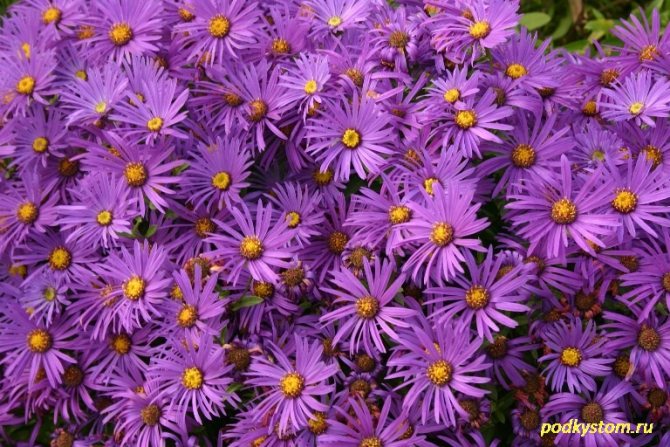

Historical reference
During excavations in the Crimea on a tomb, which was about two thousand years old, archaeologists found an image of an aster. This indicates that the plant has been known to people for a very long time. Aster came to Europe from China. In 1728, its seeds were donated to the French botanist A. Jussier. He was the first to grow these plants in the royal garden of Trianon. Their flowers resembled those of daisies, but they were much larger, so Jussier called them “queens of daisies”. After several decades, European breeders have bred many new varieties of asters, including perennial ones.
The difference between planting perennial and annual asters in open ground
Annual or perennial plants are planted in open ground in early spring or autumn. The garden bed is prepared in advance, dug up with mineral fertilizers and grooves are formed. Annuals bloom in the same year, perennials bloom in a year.
When planting perennial representatives of the family, only fresh planting material is used. A one-year-old aster can be 1-2 years old. There are no particularly critical differences, it is necessary to comply with the technology and comply with agrotechnical requirements.
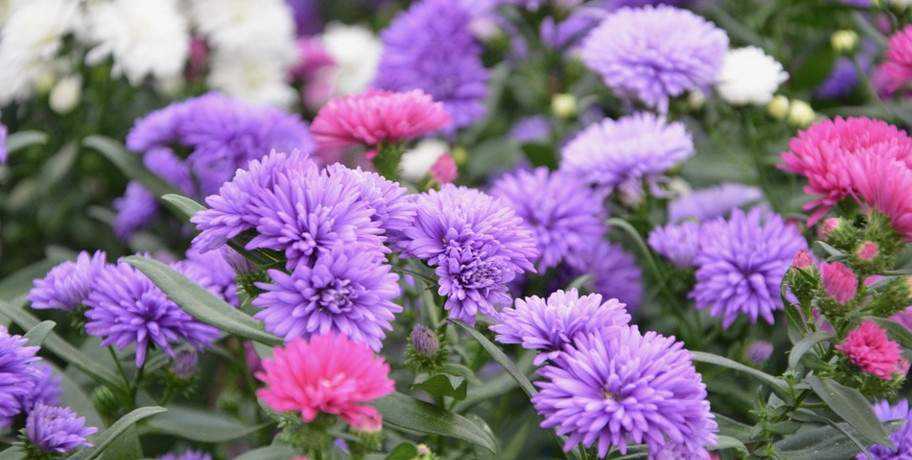

Legend
The thin petals of the aster are a bit like the rays of distant stars, so this beautiful flower was named “aster” (Latin “master” - “star”). An ancient belief says that if you go out into the garden at midnight and stand among the asters, you can hear a quiet whispering. These are flowers that communicate with the stars. Already in ancient Greece, people were familiar with the constellation Virgo, which was associated with the goddess of love Aphrodite. According to ancient Greek myth, the aster arose from cosmic dust when the Virgo looked from the sky and cried. For the ancient Greeks, aster symbolized love. In China, asters symbolize beauty, precision, elegance, charm and modesty.
For Hungarians, this flower is associated with autumn, which is why in Hungary the aster is called the “autumn rose”. In ancient times, people believed that if a few aster leaves were thrown into a fire, then the smoke from this fire could drive out snakes. The aster flower is a symbol of women born under the astrological sign of Virgo.
Biological traits
The genus includes about 600 species. Asters are bushy herbaceous annuals or summer plants with straight green (sometimes reddish) stems. Their height varies from 30 cm to 1.5 m. The root system of asters is compact, so it needs good nutrition. The leaves are simple. The flowering time of asters depends on their type and variety, but mostly they bloom from late summer to late autumn. Aster inflorescences are baskets that can be collected in a panicle. The color of the flowers is white, pink, red, lilac, cream, purple or blue, depending on the variety and variety. Thanks to active selection, the number of aster varieties today exceeds four thousand.
Asters are annual and perennial. Both are rather unpretentious. However, their decorative effect is directly related to the conditions in which they grow. It will be nice if the asters occupy a sunny area in the garden or on the balcony.In this case, it is more likely that in a short summer, the plants will have time to bloom. Asters are undemanding to soil, but stagnant moisture can lead to root rot. Perennial asters reproduce by seeds and vegetatively, and annuals only by seeds. Perennial asters are good honey plants.
Seedling care
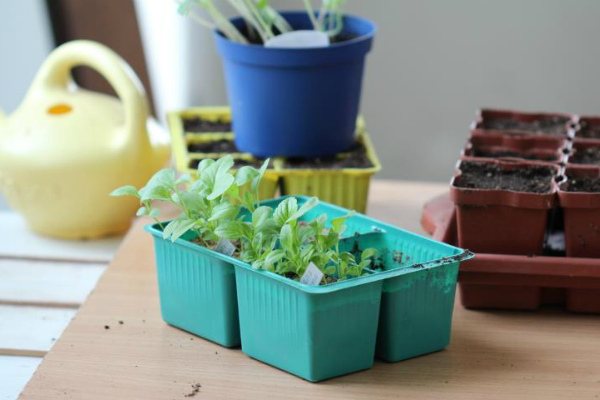

Watering
Watering the seedlings is very important when the topsoil dries out. It is best to use a spray bottle to avoid overflow and erosion of the earth. It will also avoid damage to the still very weak root system of asters.
Note! The water should be warm, and first, it should be allowed to settle.
Overflowing seedlings is not that impossible, but strictly prohibited. This will lead to the appearance of a disease such as black leg.
Top dressing


Seedlings should be fed only once. This is done five to seven days after the pick. The best option for asters would be to use mineral formulations. But, experienced flower growers advise to apply a mixture of nitrate, superphosphate and water as fertilizer. Top dressing should be carried out in the morning, after which the seedlings should be watered abundantly with water.
Note! The water should be warm.
Temperature
The temperature regime should change with each stage of growing seedlings. At first, before the leaves appear, the temperature should be about twenty-two degrees Celsius (no more).
After the first shoots appear, it needs to be changed to fifteen degrees Celsius. This will reduce the active growth of the plant in height.
As soon as full-fledged leaves appear, a pick is carried out, then you can return the temperature to the initial mode.
Picking
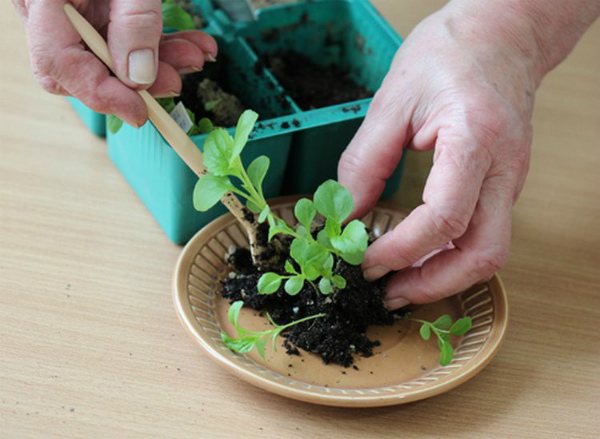

The pick is carried out after the appearance of two or three full-fledged leaves of the plant.
- The soil is prepared exactly the same as before, but only with the addition of complex mineral fertilizer. It should be evenly distributed, while mixing well.
- The pot needs to be filled with soil, tamped down. Do this so that after watering it does not settle.
- In the center of the pot, you will need to make a depression, where you will then place the roots of the aster seedling.
- If the aster has a strong branching of the roots, then it will be necessary to pinch the plant.
- When transplanting, it is very important to deepen the seedling one centimeter into the soil. Watch out for no more! Compact the soil around it. It is also very important that when watering the seedling is not simply washed off with water.
Note! Picking is a very important stage in growing a plant, since this process allows you to thin out the seedlings, accelerate their growth, and make the development of the plant much better.
Growing aster seedlings without picking - video
Lighting
Aster is a fairly light-loving plant. At any stage of cultivation, you need to provide the plant with good lighting. If you made an early planting of a flower, you will need to additionally illuminate the boxes with seedlings. You can use a phytolamp specially prepared for this purpose. If you don't have one, then a regular incandescent lamp will do. It will perfectly warm the soil with seedlings.


